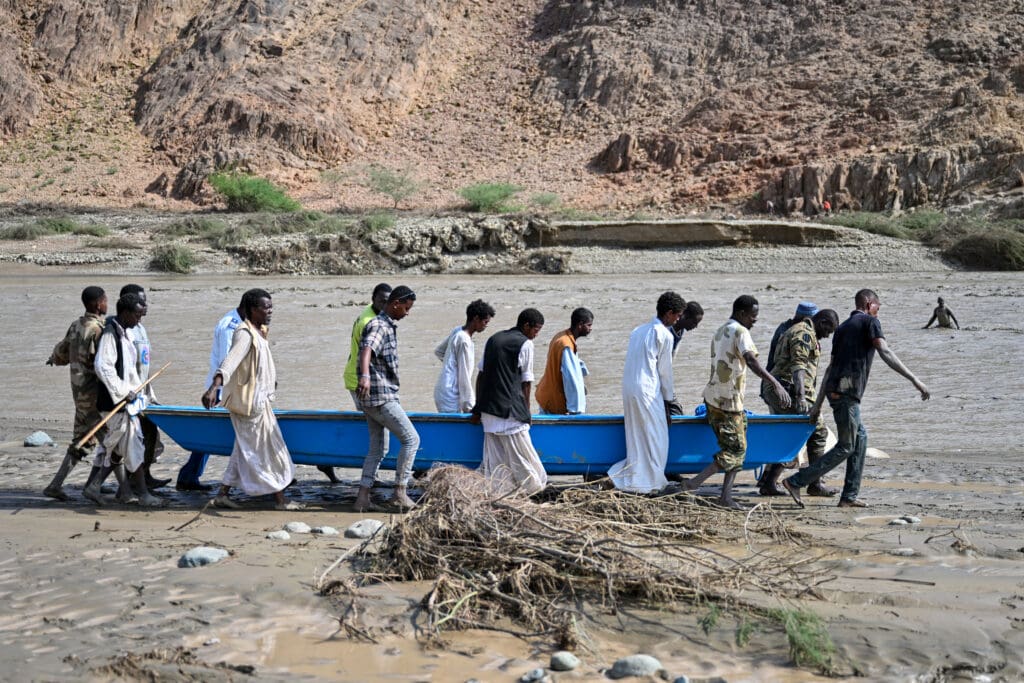The deadly collapse of a dam in Sudan following torrential rains has highlighted the country’s perilous position at the nexus of a devastating conflict and the climate crisis. The Arbaat Dam burst on August 25, destroying 20 villages and severely damaging dozens more, displacing thousands of people and cutting off critical supply routes. The flooding, a new humanitarian catastrophe within the cataclysm facing Sudan after 500 days of war, has highlighted how climate change is not just an environmental issue but also a multiplying factor in conflict and humanitarian crises.
Sudan’s history of flooding is well-documented, with each year bringing destruction to vulnerable communities across the country. However, the severity of recent floods has turned these seasonal events into existential threats for thousands of people. The Sudanese Ministry of Health said that 11 out of the country’s 18 states had been impacted by this year’s flooding, completely destroying 18,665 homes and damaging another 14,947. The death toll was at least 173 at the time of writing, with 505 people injured. The disaster left thousands of families displaced and struggling to rebuild. The intense rainfall that led to the collapse of the Arbaat Dam also resulted in the deaths of at least 60 people and displaced thousands more, damaging critical infrastructure, further complicating rescue efforts and isolating affected areas.
Moreover, Sudan’s main seaport and de facto capital, Port Sudan, which had been heavily reliant on the Arbaat Dam for its water supply, now faces a severe water crisis, exacerbating the suffering of a population already burdened by war. The dam reservoir—the city’s main water source—has been fully depleted, leaving thousands without access to clean water.
Amplifying Existing Crises
The war in Sudan, now underway for nearly a year and a half, has wreaked unimaginable suffering on an already impoverished country. Approximately 25.6 million Sudanese are now facing acute hunger, with more than 755,000 on the brink of famine, according to the United Nations. Famine has been confirmed in the Zamzam camp for internally displaced people (IDPs) in North Darfur, and the situation is critical in conflict-affected regions like Al-Jazirah, Darfur and Kordofan—as well as the capital of Khartoum itself.
Flooding and outbreaks of disease have exacerbated the suffering already caused by the fighting, especially for women and girls. A July report by Médecins Sans Frontières (MSF) detailed the catastrophic toll the conflict has taken on civilians, with hospitals shelled, markets bombed and homes razed. In just one MSF-supported hospital in Omdurman, over 6,700 patients were treated for conflict-related injuries in less than nine months.
In states where governance is weak or non-existent, environmental shocks like floods, droughts and extreme heatwaves do not just cause immediate harm. Rather, they amplify existing crises. The flooding in Sudan has magnified the impact of the conflict, which in turn has paralyzed the country’s ability to respond to the floods, just as years of civil war and unrest in Libya hindered efforts to prevent and respond to the flood caused by the collapse of two dams in Derna a year ago.
Long before the current war between the Sudanese Armed Forces (SAF) and the Rapid Support Forces (RSF), seasonal floods were already a deadly annual occurrence. However, the current conflict has damaged infrastructure, which combined with extreme weather patterns, fueled by climate change, has transformed flooding from a seasonal hardship into a full-blown humanitarian disaster.
The collapse of the Arbaat Dam is also emblematic of how Sudan’s infrastructure is chronically ill-equipped to handle such floods. Irregular maintenance, inadequate drainage systems and the lack of effective flood defenses have left many areas vulnerable. For years before the war, entire neighborhoods were submerged, roads became impassable and emergency responses were hampered by the scale of the devastation. This vulnerability is compounded by widespread poverty and a lack of resources for recovery, leaving affected communities trapped in a cycle of destruction and rebuilding.
Drought, Floods and Instability
The flood disaster in Sudan is a vivid example of how climate change acts as a “threat multiplier,” particularly in fragile states. Like the Derna flood of September 11 and 12, 2023, and the earthquake that hit remote and impoverished parts of Morocco just days earlier, the Sudan flood took place against the backdrop of a rapidly changing climate that is driving extreme weather events.
Sudan’s geography and climate make it particularly vulnerable to the impacts of climate change. Some 72% of its land is classified as desert or semi-desert, and the country is already struggling to sustain its agricultural sector and food security. Climate change exacerbates this by increasing the frequency and severity of droughts, floods and other extreme weather events, which further degrade arable land, reduce crop yields or destroy harvests altogether, and heighten food insecurity. This, in turn, feeds into broader socio-political instability, as competition for scarce resources intensifies, driving wedges between communities and fueling existing tensions.
Moreover, climate change is exacerbating the economic challenges facing Sudan. The country’s economy, already weakened by decades of conflict and the loss of oil revenues following the secession of South Sudan in 2011, is further strained by climate-induced disruptions. Reduced agricultural productivity drives up food prices and contributes to inflation, while water scarcity hampers both urban and rural livelihoods. The resulting economic pressures make it harder for the government and local institutions to maintain stability, creating a feedback loop in which environmental degradation and economic decline fuel conflict. This in turn hobbles effective climate adaptation and mitigation efforts.
Integrated Solutions
The floods in Sudan were a tragic reminder of how climate change is deepening existing crises in conflict-affected states. Accordingly, addressing the interactions between climate change and conflict is critical to preventing future humanitarian catastrophes. The international community must act swiftly to provide immediate relief to those affected by the floods, while also supporting long-term solutions that address the root causes of the country’s vulnerabilities.
Addressing Sudan’s plight will require a coordinated and comprehensive approach that focuses both on the immediate humanitarian needs and the underlying factors driving the conflict and the nation’s environmental vulnerability. Nearly 150 humanitarian agencies are on the ground, racing against time to prevent a large-scale famine from taking hold. While over 8 million of the 14.7 million people targeted for assistance this year have received some form of aid, much more needs to be done. The UN’s 2024 Humanitarian Response Plan, which seeks $2.7 billion, was only 41% funded at the time of writing, underscoring the urgent need for additional resources.
Meanwhile, to mitigate the impact of future inundations, it is vital to build flood defenses to redirect water and reduce risks in vulnerable areas. Educating communities on flood safety, encouraging relocation from high-risk areas, and improving infrastructure could greatly reduce casualties and damage to property. In the short term, there is an urgent need to deliver tents, food and life-saving medicines, including scorpion antivenom, to those affected.
The reopening of the Adre border crossing with Chad on August 15 provided a crucial route for delivering these essential supplies to western Sudan and to Darfur in particular, offering a lifeline to those in desperate need. However, ongoing rains and floods have damaged key infrastructure, including three major bridges in Darfur, limiting the movement of aid within the region. Despite these challenges, aid trucks continue to cross the border, carrying essential supplies to nearly 195,000 people in acute need, with more convoys being prepared.
At the same time, efforts to end the conflict in Sudan must incorporate strategies for adaption and climate resilience. Peacebuilding initiatives should include provisions for rebuilding and strengthening the country’s infrastructure, ensuring that it can withstand future floods and other climate-related challenges. Without such integrated solutions, the cycle of flooding, displacement and suffering in Sudan will only continue to worsen.


